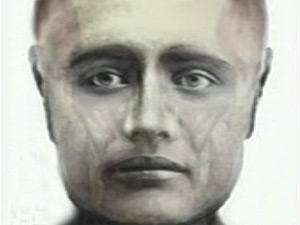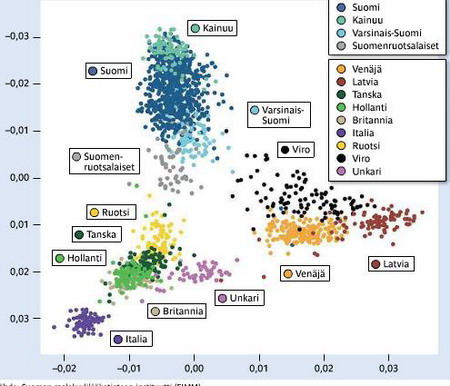BAMAD-76
Brit-Am Anthropology and DNA Update
2 May 2010 18 Iyar 5770
Contents:
1. South African Coloreds of Mainly Bushmen Origin on the Female Side
2. The Irish - more Spanish than Celtic'
3. Scottii, King Tutankhamen and a Jewish R1b Variant'
4. "Aunty": 600-year old Maori woman's face reconstructed
5. Study: Isolated Finns have unique genes
Finns genetically closer to Dutch than Hungarians
|
Brit-Am Discussion Group |
Contents by Subject |
Research Recognition Reconciliation Contribute |
|
Site Map Contents in Alphabetical Order |
This Site |
1. South African Coloreds of Mainly Bushmen Origin on the Female Side
Am J Hum Genet. 2010 Mar 24. [Epub ahead of print]
http://www.sciencedirect.com/science'_ob
=ArticleURL&_udi=B8JDD-4YP7B2W-1&_user=
10&_coverDate=03%2F25%2F2010&_rdoc=1&
_fmt=high&_orig=search&_sort=d&_docanchor
=&view=c&_acct=C000050221&_version
=1&_urlVersion=0&_userid=10&md5=
d1e8af651ece801605709cbcc0a706e5
Strong Maternal Khoisan Contribution to the South African Coloured
Population: A Case of Gender-Biased Admixture.
Quintana-Murci L, Harmant C, Quach H, Balanovsky O, Zaporozhchenko V,
Bormans C, van Helden PD, Hoal EG, Behar DM.
Extracts:
....Historical records and recent autosomal data indicate that the South African Coloured population forms a unique highly admixed population, resulting from the encounter of different peoples from Africa, Europe, and Asia.
However, little is known about the mode by which this admixed population was recently founded. Here we show, through detailed phylogeographic analyses of mitochondrial DNA and Y-chromosome variation in a large sample of South African Coloured individuals, that this population derives from at least five different parental populations (Khoisan, Bantus, Europeans, Indians, and Southeast Asians), who have differently contributed to the foundation of the South African Coloured. In addition, our analyses reveal extraordinarily unbalanced gender-specific contributions of the various population genetic components, the most striking being the massive maternal contribution of Khoisan peoples (more than 60%) andthe almost negligible maternal contribution of Europeans with respect to their paternal counterparts. The overall picture of gender-biased admixture depicted in this study indicates that the modern South African Coloured population results mainly from the early encounter of European and African males with autochthonous Khoisan females of the Cape of Good Hope around 350 years ago.
2. The Irish - more Spanish than Celtic'
Date: Tue, 13 Apr 2010 06:42:24 -0400 (EDT)
From: GAshley923@aol.com
The Irish - more Spanish than Celtic'
http://killarney-ireland.info/genealogy/
dark-irish-celt-genealogy.html
Extracts:
Scientists have concluded that the Celts did not invade Ireland en masse, nor did they replace an earlier group.
Despite the widely held belief that the Irish are descended from Celts who invaded Ireland about 2,500 years ago, a 2004 genetic research study at Trinity College, Dublin (TCD) appears to argue against it.
The Celtic cultural heritage in Ireland is prolific and informs the common perceptions and beliefs about the national identity and its origins. From traditional cultural sources in language, legend and literature the Celtic influence is strong and can also be found in contemporary culture such as Enya and the Afro Celt Sound System. The research however suggests that our blood if not also some (at least) of our culture can or should be attributed to wider origins: Spain, Portugal, Scandinavia and North Africa.
The study, conducted by Dr. Dan Bradley and Brian McEvoy, a Ph.D student conducted this genetic study with the support of the Irish government to determine 'whether there was a large incursion by Celtic people 2,500 years ago' as is widely believed.
They found that the Irish samples matched those around Britain and the Pyrenees in Spain. There were some matches in Scandinavia and parts of North Africa.
The TCD study produced a map of Europe with contours linking places that are genetically similar. One contour goes around the edge of the Atlantic touching Wales, Scotland, Ireland, and includes Galicia in Spain as well as the Basque region.
Some archaeologists also doubt that there was a Celtic invasion because few of their artifacts have been found in Ireland.
The findings are published in The American Journal of Human Genetics at the University of Chicago.
3. Scottii, King Tutankhamen and a Jewish R1b Variant'
From: GAshley923@aol.com
Scotti
Scotti Dictionary definition of Scotti | Encyclopedia.com: ...
Writers of the pseudo-history Lebor Gabala [Book of Invasions] claimed that the Scotti were descended from Queen Scota of Egypt. ...
www.encyclopedia.com/doc/1O70-Scotti.html - Similar
The 18th Dynasty Haplotype corresponds most likely to European R1b-ht15.
These values already triggered discussion. The Whit Athey algorithm clearly predicts haplogroup R1b at a probability of 100%. The rare value 10 at DYS439 is definitely an outlier, but in internet fora (DNA-Forums and Rootsweb) experts on the field, not all of them just enthusiastic and highly motivated hobbyists, speculated the haplotype most of all mirrors the Western European R1b-ht15 subclades, commonly defined by a fairly 'recent' SNP, labeled P310. The ancestral counterpart of R1b in Africa (that is considered ancestral and in Africa typically identifies with SNP R1b-V88, contender for being a possible Hamitic marker) or the Levant, was readily dismissed for being an unlikely candidate. This means, the Y-DNA profile of Tut's dynasty presents characteristics that were never typical to Africa, the Levant nor Egypt. Instead, the current low occurrences of Egyptian ht15 are commonly attributed to the classical period and up to modern times, when European influences coerced on Egypt through Rome and other historic entities from that same direction. At least one similar haplogroup was found among Jews, whose corresponding SNPs are labeled U152 and L4 (downstream R1b-ht15), albeit a considerable genetic distance to modal values strongly suggests an origin that is older than the Roman Empire.
How a European haplotype, having possible Jewish connotations, could have entered the Egyptian royal house to begin with? This doesn't look like an issue an Egyptian team would be eager to investigate: Starting with the political and religious animosities between Israel and Egypt, being nowadays part of the Arab world. The biblical history of the pharaoh who promoted Joseph's rise to authority (Genesis 41:39-46) and subsequent claims of an important role of the Jewish people in Egypt until Exodus, already kindled debate on the Egyptian influence in the origin of monotheism. The biblical account comes close to a complete takeover. Genesis chapter 47.
4."Aunty": 600-year old Maori woman's face reconstructed
http://dienekes.blogspot.com/
The face of a Maori woman who died on the Wairau bar in Marlborough more than 600 years ago has been revealed using digital technology.
Skulls found on the Wairau Bar in 1939 have been used to help digitally recreate the faces of the people who once lived there.
Local iwi Rangitane have affectionately renamed the woman as "aunty".
|
5. Study: Isolated Finns have unique genes
Finns genetically closer to Dutch than Hungarians
http://dna-forums.com/index.php'/topic/11248-isolated-finns-have-unique-genes/
Extracts:
Finns have been found to form a unique genetic island between Eastern and Western Europe.
The Finnish genetic makeup differs clearly from that of other European nations, says a new genetic atlas compiled by the Institute for Molecular Medicine Finland FIMM.
'There have been influences from both the east, west, and south', says FIMM researcher Samuli Ripatti.
'However, we have been isolated here to such a degree that the genotype has become unique.'
Eastern influence has come mainly from the area that is now Estonia.
Finns are genetically closer to the Estonians than they are to the Russians, who are represented on the map by residents of the Moscow area. Information from East Karelia will become available later this year, which might change the picture somewhat.
However, Ripatti says that the strongest influence in the Finnish genome comes from the west, via Sweden.
The study shows that nations who speak languages that are related to each other are not necessarily close genetically.
Finnish genes are closer to those of the Dutch than they are to those of the Hungarians, whose language is related to Finnish. Ripatti adds that genetically, the Swedes and Estonians are approximately equally close to the Finns.
Janne Saarikivi, Acting Professor of Finno-Ugric Languages at the University of Helsinki, does not see this as surprising.
'For instance, the genetic differences between the Finns and the Hungarians have been known for a long time. The languages have the same origin, but they have spread through different routes than the genes. This is quite common in history. For instance, hundreds of thousands of descendants of Swedish-speakers in Finland speak Finnish.'
There are striking genetic differences between dialect zones in Finland.
The residents of Kainuu in the northeast, and Finland Proper in the southwest are genetically more different than the Swedes are from the British.
The Helsinki region has an unusually great mixture of genetic material. He also emphasises that differences in national character cannot be directly derived from genetic heritage.
'However, people in the West of Finland are slightly taller than those from the east. There are also differences in the frequency of heart disease. Some of them can be explained by genes', Ripatti says.
The gene map was drawn up in connection with health examinations of 40,000 volunteers. The data from foreign countries came from health researchers of the different countries.
The data helps in the study of the genetic background of diseases prevalent to Finland.
The project was guided by the recently deceased geneticist Leena Peltonen-Palotie.
|
Brit-Am Comment:
Above is a genetic map of the study, copied from the Helsingin Sanomat article:
http://dna-forums.com/index.php'/topic/11248-isolated-finns-have-unique-genes/
This map is a bit difficult to understand so we may be mistaken.
It would seem that the Finns of Swedish origin (Ruotsi?) are almost identical to the Dutch and close to the British.
The Finns Proper (Suomi') are as close (or a bit closer') to the British and Dutch as they are to the Latvians.
The influence of the Lapps (especially in Kainuu) may account for some of the other DNA distance?
[If we are mistaken we hope that someone from Finland or elsewhere will correct us.]
It is interesting to note that the female mtDNA of the Lapps is the same as of the Berber females n North Africa!!

Pleased with what you read?
Click Here to make an offering. |
'It is impossible to rightly govern the world without God or the Bible.'
George Washington
Brit-Am is the "still small voice" that contains the truth.
[1-Kings 19:12] AND AFTER THE EARTHQUAKE A FIRE; BUT THE LORD WAS NOT IN THE FIRE: AND AFTER THE FIRE A STILL SMALL VOICE.
| PREVIOUS ISSUES |
 |
 |


